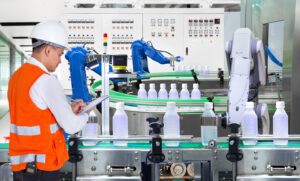Have you ever thought about the journey your package makes when you order something online? The logistics of how goods are moved along the supply chain can and are having a huge impact on business around the world. And as e-commerce grows at a high rate while labor shortages worsen, supply chains across the world are feeling the squeeze.
Gartner recently published a report into supply chain leaders. It found that companies with leading supply chains are using technology that puts people at the center of their digital transformation. To this end, advanced robotics technology has a role to play in helping solve some of these workforce challenges, filling the labor gap and creating safer workplaces overall.
How robotics can help the labor shortage in distribution centers and make workers safer
If labor shortages were a challenge for logistics before the pandemic, they’re having an even greater impact now. Let me elaborate; at some point, your parcel will go through a distribution center, where it will be sorted. From the perspective of a person, material handling is a tough job. It’s fast-paced, laborious, physically demanding work.
But with changing workforce demographics and the disruptions of the last few years, it’s been harder and harder to find people to do these jobs. Meanwhile, e-commerce has surged. What was a labor challenge is now a labor crisis.
Automation could potentially help but historically motion control and robotic technologies were simply not advanced enough to handle the variances involved and while maintaining speed and accuracy. With postage services in particular, each package is a different size and weight, and needs to be handled accordingly. In a factory, automated pick and place is usually done with the same product, so part sizes and weights are always the same. However, in a postal facility or distribution center, you can be working with anything from the size of a 100g envelope to a 7-8kg box.
As a result, the scope of automation in material handling has been limited and seasonal workers were often relied on to fill the gaps during busy periods.
Robotics is paving the way for automation in material handling
In the last ten years or so, major technological breakthroughs in AI and robotics have changed the game when it comes to automation in material handling. MHS is one of our long-standing partners and together we’ve been working hard to develop a robotic solution that can handle the different sizes and shapes of packages going through distribution centers.
Called robotic singulation automated induction, it’s based on our PacDrive 3 Delta robot. The key to its success is that instead of simply being programmed to pick up the same object over and over, it uses computer vision software and algorithms to identify each individual parcel and measure how much effort it takes to lift it. Vacuum-based suction cups and grippers then pick individual items and orient them in single file, ready for downstream processing.
Before it simply wasn’t possible to use robotics to perform such complex actions. Thanks to the vision system and the AI, combined with the small footprint, solutions like this can now be applied in many more & different customer applications. On top of this, with machine learning production data can be used to improve the software operation and in turn, help the system improve performance over time.
‘We chose your [Schneider Electric] Delta robot because it’s one of the fastest robots in the industry’, Brandon Coats, MHS Global Product Manager.
Making workers safer with advanced robotic technology
Some of our other customers are using robotic technology to help improve workplace safety. Recently a pick and place automation system, also based on the PacDrive3 – Delta robot, was installed in a slate roofing tile manufacturing plant to stack and unstack tiles as part of the customer’s rounding machine modernization project. As well as helping address worker shortages, a major goal was to increase production while avoiding injury from repetitive movements.
With safety and labor being top priorities for industrial businesses around the world, these are just a few examples of potential uses for automation in material handling applications for logistics. And who knows, maybe these advances in automation can help your parcel arriver faster, too!
So next time you’re waiting on a package, spare a thought for the person, or maybe even robot, who worked hard to guide it on the journey.



